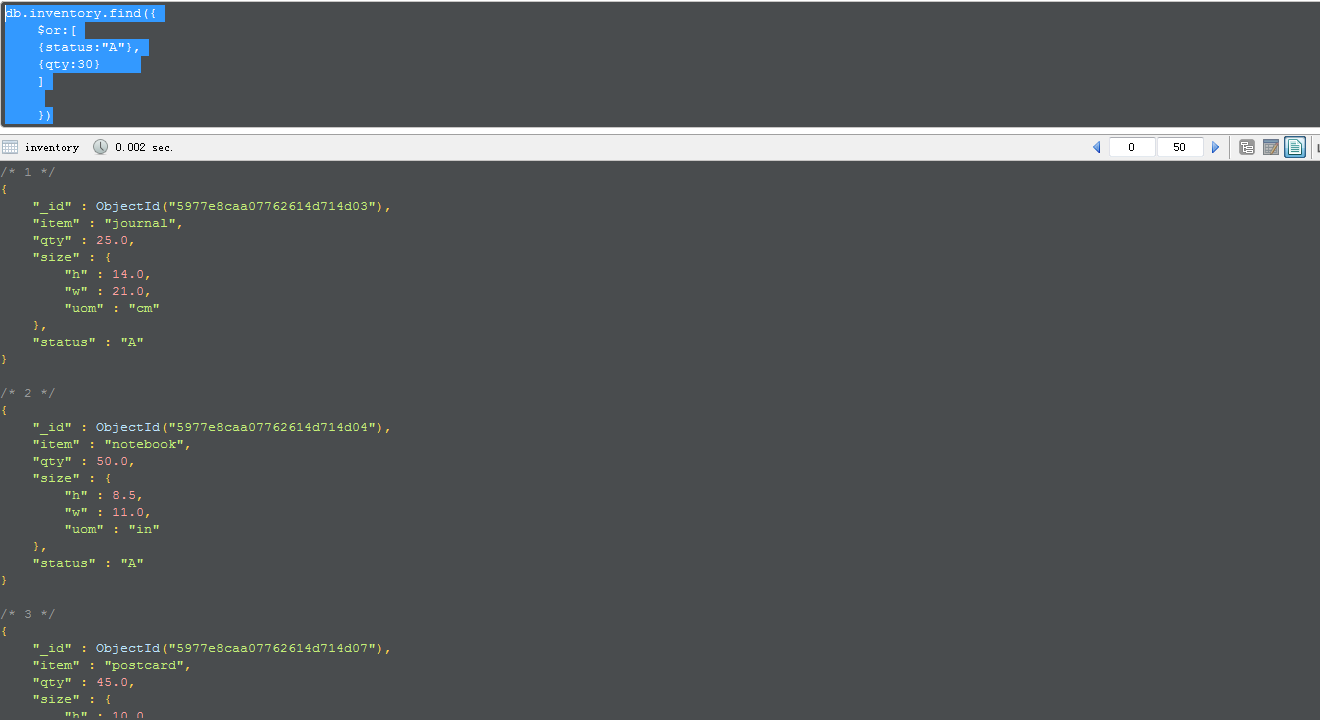总结
1 先插入数据
db.inventory.insertMany([ { item: "journal", qty: 25, size: { h: 14, w: 21, uom: "cm" }, status: "A" }, { item: "notebook", qty: 50, size: { h: 8.5, w: 11, uom: "in" }, status: "A" }, { item: "paper", qty: 100, size: { h: 8.5, w: 11, uom: "in" }, status: "D" }, { item: "planner", qty: 75, size: { h: 22.85, w: 30, uom: "cm" }, status: "D" }, { item: "postcard", qty: 45, size: { h: 10, w: 15.25, uom: "cm" }, status: "A" } ])
2 查询所有数据
db.inventory.find({})

3 指定相等条件
db.inventory.find({
status:"D"
})

4 指定查询运算条件
db.inventory.find({ status:{ $in:["A","D"] } } )

5 指定and的条件
db.inventory.find({ status:"A", qty:{$lt:30} })

6 指定or条件
db.inventory.find({ $or:[ {status:"A"}, {qty:30} ] })

7 指定and和or的条件
db.inventory.find({ status:"A", $or:[ {qty:{ $lt:30 }}, {item:/^p/} ] })

This page provides examples of query operations using the db.collection.find() method in the mongoshell. The examples on this page use the inventory collection. To populate the inventory collection, run the following:
db.inventory.insertMany([
{ item: "journal", qty: 25, size: { h: 14, w: 21, uom: "cm" }, status: "A" },
{ item: "notebook", qty: 50, size: { h: 8.5, w: 11, uom: "in" }, status: "A" },
{ item: "paper", qty: 100, size: { h: 8.5, w: 11, uom: "in" }, status: "D" },
{ item: "planner", qty: 75, size: { h: 22.85, w: 30, uom: "cm" }, status: "D" },
{ item: "postcard", qty: 45, size: { h: 10, w: 15.25, uom: "cm" }, status: "A" }
]);
You can run the operation in the web shell below:
Select All Documents in a Collection
To select all documents in the collection, pass an empty document as the query filter parameter to the find method. The query filter parameter determines the select criteria:
db.inventory.find( {} )
These operation corresponds to the following SQL statement:
SELECT * FROM inventory
For more information on the syntax of the method, see find().
Specify Equality Condition
To specify equality conditions, use <field>:<value> expressions in the query filter document:
{ <field1>: <value1>, ... }
The following example selects from the inventory collection all documents where the status equals "D":
db.inventory.find( { status: "D" } )
This operation corresponds to the following SQL statement:
SELECT * FROM inventory WHERE status = "D"
Specify Conditions Using Query Operators
A query filter document can use the query operators to specify conditions in the following form:
{ <field1>: { <operator1>: <value1> }, ... }
The following example retrieves all documents from the inventory collection where status equals either"A" or "D":
db.inventory.find( { status: { $in: [ "A", "D" ] } } )
Although you can express this query using the $or operator, use the $in operator rather than the $oroperator when performing equality checks on the same field.
The operation corresponds to the following SQL statement:
SELECT * FROM inventory WHERE status in ("A", "D")
Refer to the Query and Projection Operators document for the complete list of MongoDB query operators.
Specify AND Conditions
A compound query can specify conditions for more than one field in the collection’s documents. Implicitly, a logical AND conjunction connects the clauses of a compound query so that the query selects the documents in the collection that match all the conditions.
The following example retrieves all documents in the inventory collection where the status equals "A"and qty is less than ($lt) 30:
db.inventory.find( { status: "A", qty: { $lt: 30 } } )
The operation corresponds to the following SQL statement:
SELECT * FROM inventory WHERE status = "A" AND qty < 30
See comparison operators for other MongoDB comparison operators.
Specify OR Conditions
Using the $or operator, you can specify a compound query that joins each clause with a logical ORconjunction so that the query selects the documents in the collection that match at least one condition.
The following example retrieves all documents in the collection where the status equals "A" or qty is less than ($lt) 30:
db.inventory.find( { $or: [ { status: "A" }, { qty: { $lt: 30 } } ] } )
The operation corresponds to the following SQL statement:
SELECT * FROM inventory WHERE status = "A" OR qty < 30
NOTE
Queries which use comparison operators are subject to Type Bracketing.
Specify AND as well as OR Conditions
In the following example, the compound query document selects all documents in the collection where thestatus equals "A" and either qty is less than ($lt) 30 or item starts with the character p:
db.inventory.find( {
status: "A",
$or: [ { qty: { $lt: 30 } }, { item: /^p/ } ]
} )
The operation corresponds to the following SQL statement:
SELECT * FROM inventory WHERE status = "A" AND ( qty < 30 OR item LIKE "p%")
NOTE
MongoDB supports regular expressions $regex queries to perform string pattern matches.
Additional Query Tutorials
For additional query examples, see:
Behavior
Cursor
The db.collection.find() method returns a cursor to the matching documents.
Read Isolation
New in version 3.2.
For reads to replica sets and replica set shards, read concern allows clients to choose a level of isolation for their reads. For more information, see Read Concern.
Additional Methods
The following methods can also read documents from a collection:
db.collection.findOne- In aggregation pipeline, the
$matchpipeline stage provides access to MongoDB queries.
NOTE
The db.collection.findOne() method also performs a read operation to return a single document. Internally, the db.collection.findOne() method is the db.collection.find() method with a limit of 1.